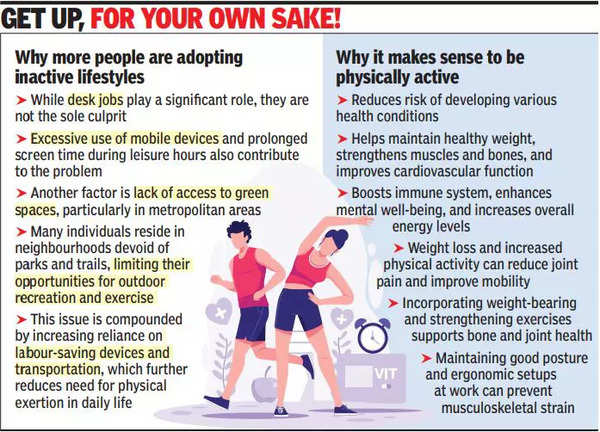- News
- India News
- Every second Indian adult physically inactive, fails WHO guidelines: Study
Trending
Every second Indian adult physically inactive, fails WHO guidelines: Study
The discussion revolves around the critical issue of Indian adults failing to meet WHO physical activity guidelines, leading to various health risks. A sedentary lifestyle is linked to a surge in lifestyle-related diseases, impacting both physical and mental well-being. Prioritizing wellness and combating the dangers of sedentary habits is essential for a healthier lifestyle.

NEW DELHI: Nearly 50% of Indian adults are unfit and fail to adhere to World Health Organisation (WHO) recommendations for adequate physical activity, according to a study published in medical journal The Lancet Global Health on Tuesday.
The research, conducted across 197 countries and territories from 2000 to 2022, highlighted a significant gender disparity, with 52.6% of women and 38.4% men found physically inactive in 2022.The most concerning aspect of the findings was the dramatic increase in the prevalence of insufficient physical activity among Indian adults, which surged from 22.4% in 2000 to 45.4% in 2022. If the trend of 2010-22 continues, levels of inactivity are projected to rise to 55% by 2030.

To maintain optimal health, WHO recommends adults to engage in “150 minutes of moderate-intensity or 75 minutes of vigorous-intensity physical activity, or equivalent, per week”. Failing to meet these guidelines can lead to serious health consequences. Physically inactive adults are more susceptible to developing various cardiovascular diseases and face an increased risk of type 2 diabetes, dementia and breast and colon cancer.
According to city-based doctors, the lack of physical activity and increased consumption of unhealthy food are among major factors contributing to the rise in li- festyle-related diseases. With everything available on mobile phones, people have stopped going to markets, further reducing physical movement. The availability of snacks and beverages within the office has also limited the need for employees to move around. This
“In our OPD, we see a substantial number of patients with orthopaedic issues related to sedentary lifestyles and poor diets. In a month, the number of such patients ranges between 15 and 25. This indicates that these conditions are prevalent and increasing,” said Dr Hitesh Bhandari, consultant, orthopaedics, Indian Spinal Injuries Centre.
He added, “Sedentary lifestyles and consumption of junk food are key contributors to diseases. These include osteoporosis, where a lack of weight-bearing exercise can lead to weaker bones, and osteoarthritis, which is exacerbated by obesity caused by poor diet and inactivity. Chronic lower back pain is another common issue, resulting from poor posture and weak core muscles due to inactivity. Adults aged 40-65 are most affected by a sedentary lifestyle in terms of orthopaedic health. This age group often has desk jobs and establishes sedentary habits, leading to musculoskeletal problems.”
Dr Balbir Singh, group chairman, cardiac sciences, Max Super Speciality Hospital, Saket, emphasised the significant health risks associated with a sedentary lifes- tyle, particularly in relation to cardiovascular diseases, which affect both the heart and the brain. These ailments are a major concern for people who engage in minimal physical activity. A sedentary lifestyle is also linked to issues like hypertension, diabetes and obesity.
“The consequences of a sedentary lifestyle are more pronounced in older age groups, particularly those aged 40 and above. However, in recent years, there has been a significant change in the lifestyle habits of younger groups. The younger generation is also being impacted, as many work on computers and avoid in-person interactions. Online meetings and lack of walking are becoming prevalent among them. At least 80% of the people who visit my OPD lead a sedentary lifestyle,” said Dr Singh.
Women tend to lead a more inactive lifestyle compared to men, he added. Many women believe working in the kitchen and performing household chores constitute significant physical activity, and they often claim to be very active as a result. However, this perception is inaccurate, he said.
Dr Anoop Saraya, a gastroenterologist from ILBS, said annual check-ups and corporate health screenings have been instrumental in identifying health issues through incidental findings.
“Individuals with fatty liver are at a higher risk of developing non-alcoholic fatty liver disease, which can progress to liver fibrosis, scarring and cell destruction. In advanced stages, this condition may lead to cirrhosis, and those with cirrhotic liver have a higher likelihood of developing liver cancer compared to the general population. The progression from fatty liver to liver malignancy can span over 20-25 years,” he said, adding genetic predisposition plays a crucial role in the development of certain diseases. When coupled with unhealthy eating habits, the risk of developing these conditions increases.
According to Dr Pragya Shukla, head of clinical oncology department at Delhi State Cancer Institute, “There is an increasing trend of cancer incidence in the younger population. Breast and colon cancers are directly or indirectly affected by a sedentary lifestyle.”
The sedentary nature of modern lifestyles, characterised by prolonged periods of sitting and minimal exercise, has been identified as a significant risk factor for cancer occurrence across all age groups, particularly among young people, she said.
“Insufficient exercise can contribute to psychological issues, and there is a correlation between eating unhealthy food and experiencing anxiety and depression,” said Dr Praveen Gupta, principal director and chief of neurology, Fortis Hospital.
A sedentary lifestyle may negatively impact a person’s mental well-being. Moreover, the consumption of nutrientpoor, high-calorie foods has been associated with increased levels of stress and low mood.
The research, conducted across 197 countries and territories from 2000 to 2022, highlighted a significant gender disparity, with 52.6% of women and 38.4% men found physically inactive in 2022.The most concerning aspect of the findings was the dramatic increase in the prevalence of insufficient physical activity among Indian adults, which surged from 22.4% in 2000 to 45.4% in 2022. If the trend of 2010-22 continues, levels of inactivity are projected to rise to 55% by 2030.

To maintain optimal health, WHO recommends adults to engage in “150 minutes of moderate-intensity or 75 minutes of vigorous-intensity physical activity, or equivalent, per week”. Failing to meet these guidelines can lead to serious health consequences. Physically inactive adults are more susceptible to developing various cardiovascular diseases and face an increased risk of type 2 diabetes, dementia and breast and colon cancer.
TIMESVIEW
Inactivity can lead to both physical and mental issues. Unfortunately, modern office work often doesn't encourage physical activity. The report rightly reasserts the dangers of a sedentary lifestyle. We must prioritise the wellness of our own body, take time out to take care of it. There’s no better investment than yourself.
According to city-based doctors, the lack of physical activity and increased consumption of unhealthy food are among major factors contributing to the rise in li- festyle-related diseases. With everything available on mobile phones, people have stopped going to markets, further reducing physical movement. The availability of snacks and beverages within the office has also limited the need for employees to move around. This
sedentary lifestyle affects all age groups.
“In our OPD, we see a substantial number of patients with orthopaedic issues related to sedentary lifestyles and poor diets. In a month, the number of such patients ranges between 15 and 25. This indicates that these conditions are prevalent and increasing,” said Dr Hitesh Bhandari, consultant, orthopaedics, Indian Spinal Injuries Centre.
He added, “Sedentary lifestyles and consumption of junk food are key contributors to diseases. These include osteoporosis, where a lack of weight-bearing exercise can lead to weaker bones, and osteoarthritis, which is exacerbated by obesity caused by poor diet and inactivity. Chronic lower back pain is another common issue, resulting from poor posture and weak core muscles due to inactivity. Adults aged 40-65 are most affected by a sedentary lifestyle in terms of orthopaedic health. This age group often has desk jobs and establishes sedentary habits, leading to musculoskeletal problems.”
Dr Balbir Singh, group chairman, cardiac sciences, Max Super Speciality Hospital, Saket, emphasised the significant health risks associated with a sedentary lifes- tyle, particularly in relation to cardiovascular diseases, which affect both the heart and the brain. These ailments are a major concern for people who engage in minimal physical activity. A sedentary lifestyle is also linked to issues like hypertension, diabetes and obesity.
“The consequences of a sedentary lifestyle are more pronounced in older age groups, particularly those aged 40 and above. However, in recent years, there has been a significant change in the lifestyle habits of younger groups. The younger generation is also being impacted, as many work on computers and avoid in-person interactions. Online meetings and lack of walking are becoming prevalent among them. At least 80% of the people who visit my OPD lead a sedentary lifestyle,” said Dr Singh.
Women tend to lead a more inactive lifestyle compared to men, he added. Many women believe working in the kitchen and performing household chores constitute significant physical activity, and they often claim to be very active as a result. However, this perception is inaccurate, he said.
Dr Anoop Saraya, a gastroenterologist from ILBS, said annual check-ups and corporate health screenings have been instrumental in identifying health issues through incidental findings.
“Individuals with fatty liver are at a higher risk of developing non-alcoholic fatty liver disease, which can progress to liver fibrosis, scarring and cell destruction. In advanced stages, this condition may lead to cirrhosis, and those with cirrhotic liver have a higher likelihood of developing liver cancer compared to the general population. The progression from fatty liver to liver malignancy can span over 20-25 years,” he said, adding genetic predisposition plays a crucial role in the development of certain diseases. When coupled with unhealthy eating habits, the risk of developing these conditions increases.
According to Dr Pragya Shukla, head of clinical oncology department at Delhi State Cancer Institute, “There is an increasing trend of cancer incidence in the younger population. Breast and colon cancers are directly or indirectly affected by a sedentary lifestyle.”
The sedentary nature of modern lifestyles, characterised by prolonged periods of sitting and minimal exercise, has been identified as a significant risk factor for cancer occurrence across all age groups, particularly among young people, she said.
“Insufficient exercise can contribute to psychological issues, and there is a correlation between eating unhealthy food and experiencing anxiety and depression,” said Dr Praveen Gupta, principal director and chief of neurology, Fortis Hospital.
A sedentary lifestyle may negatively impact a person’s mental well-being. Moreover, the consumption of nutrientpoor, high-calorie foods has been associated with increased levels of stress and low mood.
End of Article
FOLLOW US ON SOCIAL MEDIA










